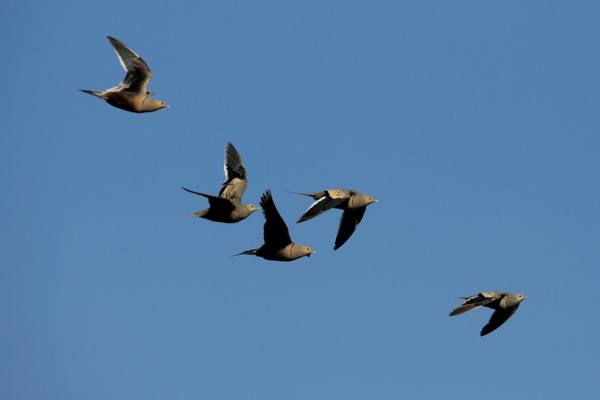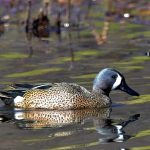Common Name: Chestnut-bellied Sandgrouse
Scientific Name: Pterocles exustus| Size | Diet | Range in Hawaii | Status in Hawaii |
|---|---|---|---|
| 11 in. | small seeds, small insects and fallen berries | Big Islands | least concern |
The Chestnut-bellied Sandgrouse (Pterocles exustus) is a small, ground-dwelling bird that is native to Africa and the Middle East. It is a member of the sandgrouse family, which includes a group of birds that are adapted to living in arid environments.
Chestnut-bellied Sandgrouse
Appearance

It is a plump, short-tailed bird with a length of about 11 inches (28 cm) and a wingspan of about 18 inches (45 cm). The Chestnut-bellied Sandgrouse has a sandy brown head, neck, and breast, with a distinctive chestnut-colored belly. It has long, pointed wings and a short, square tail.
Diet
It feeds primarily on seeds and grains, which it obtains by foraging on the ground. Chestnut-bellied Sandgrouse may also eat small amounts of insects and other invertebrates, which it finds while foraging on the ground. It has a small, sharp beak that is well-suited to picking up and processing small seeds and grains.
Behavior

The Chestnut-bellied Sandgrouse is a monogamous species and forms pair bonds that last for a single breeding season. The male courts the female with a series of elaborate displays, including fluffing his feathers and making loud, distinctive calls.
The female lays a clutch of 2 to 3 eggs in a shallow scrape on the ground, which are incubated by both the male and the female. The chicks are fed by both parents until they fledge, or leave the nest.
The Chestnut-bellied Sandgrouse is a territorial species and will defend its territory against intruders, especially during the breeding season. It is a vocal species and is known for its distinctive, high-pitched calls, which are often heard during flight. It is also a highly agile flyer and is known for its acrobatic maneuvers, including steep dives and sharp turns.
Nesting
The Chestnut-bellied Sandgrouse is a ground nester, and it builds its nest in a shallow scrape on the ground. The female lays a clutch of 2 to 3 eggs, which are incubated by both the male and the female. The chicks are fed by both parents until they fledge, or leave the nest.
Habitat
In its native range, the Chestnut-bellied Sandgrouse is found in a wide variety of habitat types, including grasslands, savannas, woodlands, and scrublands. It is a ground-dwelling bird and is often seen foraging on the ground in open habitats. It is a social species and is often seen in small flocks, especially during the non-breeding season.
Range
The Chestnut-bellied Sandgrouse can be found on the Big Island. However, it is important to note that the Chestnut-bellied Sandgrouse is not a native species to Hawaii and was introduced to the islands. It is considered a released cage bird and is not found in the wild in its native range.
Conservation Status
The Chestnut-bellied Sandgrouse is not listed as a threatened or endangered species by the International Union for Conservation of Nature (IUCN). It has a large, stable population and is found in a wide range of habitats throughout Africa and the Middle East.
Interesting facts
1. They are a monogamous species
The Chestnut-bellied Sandgrouse is a monogamous species and forms pair bonds that last for a single breeding season.
2. They are “social species”.
The Chestnut-bellied Sandgrouse is a social species and is often seen in small flocks, especially during the non-breeding season.
3. A strong flyer
The Chestnut-bellied Sandgrouse is a strong flyer and is known for its ability to fly long distances in search of food and water.
4. They are Territorial species
The Chestnut-bellied Sandgrouse is a territorial species and will defend its territory against intruders, especially during the breeding season. It is also a highly agile flyer and is known for its acrobatic maneuvers, including steep dives and sharp turns.
Frequently asked questions:
Is Chestnut-bellied Sandgrouse native in Hawaii?
It is not native to the Hawaiian Islands and is not known to occur there regularly.
How Long Does A Chestnut-Bellied Sandgrouse Live?
There is limited information available on the lifespan of Chestnut-bellied Sandgrouse in the wild. However, it is likely that these birds can live for several years, with some individuals potentially reaching up to 10 years of age or more. Factors that can impact the lifespan of Chestnut-bellied Sandgrouse include predation, disease, and environmental conditions, such as availability of food and water.
In captivity, Chestnut-bellied Sandgrouse may have a longer lifespan, with some individuals potentially living up to 15 years or more with proper care.




